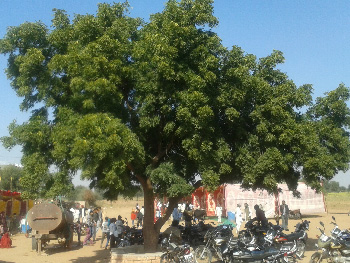The world today is racing like a sophisticated four-wheeler that has no intentions to stop. We seem to have revolutionized our living is such a manner that nothing seems old fashioned. However, is this applicable to all the areas of life? Agreed, technology and scientific developments have made our lives comfortable, these keep on changing, and innovation is the magical word in these fields. But what is more intriguing is that the cultures even today are considered as interesting areas of study and many people are fascinated by the very thought of understanding or taking a peep into the foreign culture.
 One such interesting area is the way people clean their teeth and how the people maintain oral health. Today we have so many toothpastes and even different brands of toothbrushes around us. Nevertheless, even today in some parts of the world people do not make use of toothpastes and stick to the conventional and trustworthy methods of cleaning teeth. One such country is India where people in the rural areas resort to using different forms of oral health like the twigs. The word twig immediately brings forth the medicinal and most trusted tree, which is none other than the neem tree. So how is neem used for cleaning the teeth? The neem twig (known as neem datun) is broken into parts, softened and then rubbed on the teeth. Neem is considered as “Village Pharmacy” because of its exceptional qualities, which help in maintaining oral hygiene. This neem tree (Azadirachta indiaca being its scientific name) is plant native to India. In spite of absence of other oral care products people enjoy good oral health all thanks to this useful plant. In rural India, it is a common practice to chew the neem twig. What is done is that the thin neem twigs are chewed and then split thereby cleaning the tongue. The rural folks in India follow this practice since many hundred years and oral hygiene in India is taken care pretty well by this tree. A high number of people in the Indian villages use neem for cleaning their teeth and for them neem twig is nothing but a toothbrush as they use it in a manner in which toothbrush is used. Though not that great in taste, these neem twigs are given, the appearance of toothbrushes (though not refined one) and the end is chewed until it turns soft and once this is done the teeth is brushed by this twig.
One such interesting area is the way people clean their teeth and how the people maintain oral health. Today we have so many toothpastes and even different brands of toothbrushes around us. Nevertheless, even today in some parts of the world people do not make use of toothpastes and stick to the conventional and trustworthy methods of cleaning teeth. One such country is India where people in the rural areas resort to using different forms of oral health like the twigs. The word twig immediately brings forth the medicinal and most trusted tree, which is none other than the neem tree. So how is neem used for cleaning the teeth? The neem twig (known as neem datun) is broken into parts, softened and then rubbed on the teeth. Neem is considered as “Village Pharmacy” because of its exceptional qualities, which help in maintaining oral hygiene. This neem tree (Azadirachta indiaca being its scientific name) is plant native to India. In spite of absence of other oral care products people enjoy good oral health all thanks to this useful plant. In rural India, it is a common practice to chew the neem twig. What is done is that the thin neem twigs are chewed and then split thereby cleaning the tongue. The rural folks in India follow this practice since many hundred years and oral hygiene in India is taken care pretty well by this tree. A high number of people in the Indian villages use neem for cleaning their teeth and for them neem twig is nothing but a toothbrush as they use it in a manner in which toothbrush is used. Though not that great in taste, these neem twigs are given, the appearance of toothbrushes (though not refined one) and the end is chewed until it turns soft and once this is done the teeth is brushed by this twig.
Ayurveda has also suggested the chewing of these sticks. So much so, that it is preferred to use these twigs after every meal besides the morning use. One can also term these are herbal toothbrushes and neem is an excellent bacteria fighter. The leaves of neem tree and its bark are useful for oral health and it has several properties with respect to oral health like soothing (for infrequent inflammation), cooling for slight irritations and astringent which is for tightening the gum tissues. Neem also prevents plaque, which is a gluey residue of food particles, bacteria, and acid that consumes the tooth enamel. Thus, neem has great properties to prevent the decaying of teeth as well as the diseases of the gum.
Besides neem, oak twigs are also used for cleaning the teeth. Some tribes like the Arab Bedouin use arak tree twigs since it has antiseptic properties, while others like the people of Muslim and African cultures use a stick called miswak, which contains fluoride. In India though neem is the most popular and common plant of oral health some people like the Hindu Brahmins make use of cherry wood for cleaning their teeth, Jain people clean their teeth with their fingers instead of a toothbrush. The rural Indians along with people from other continents like the Africa and South America used other materials like charcoal, rangoli powder, salt, mud or ash for cleaning teeth. Still other twigs, which are used in India, are the twigs of eucalyptus and mango.